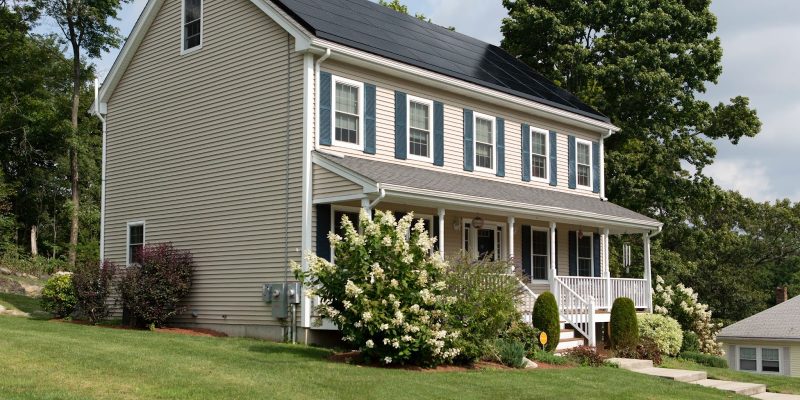When it comes to home improvement, sustainability is a concept that’s gaining tremendous momentum. With increasing awareness of environmental issues, homeowners are seeking ways to upgrade their living spaces while minimizing their impact on the planet.
Sustainable ideas for home improvement offer an exciting opportunity to combine aesthetics, functionality, and eco-consciousness.
In this article, we’ll delve into many innovative ideas that cater to both the comfort of your home and the welfare of the environment.
Energy-Efficient Lighting and Appliances
Elevate your home’s energy efficiency by embracing smart choices in lighting and appliances. Opting for energy-efficient LED bulbs in lieu of conventional incandescent ones offers substantial electricity savings. These bulbs are durable and emit less heat, ensuring a cooler ambiance during warmer seasons.
Prioritizing Energy Star-certified appliances, such as refrigerators, washing machines, and dishwashers, guarantees optimized performance with reduced energy consumption.
For example, modern Energy Star refrigerators utilize approximately 15% less energy compared to their non-certified counterparts. These minor adjustments translate to lower utility expenses and a positive environmental impact.
Water Conservation Upgrades
You can introduce several upgrades to your home that will help conserve water and lower your utility bills in the long term. One of these is installing low-flow faucets and showerheads, significantly reducing water wastage without compromising water pressure, promoting efficient usage.
Consider implementing a greywater system, which diverts gently used water from sinks and showers for irrigation purposes, reducing the demand for fresh water in your garden.
You can also prevent unnecessary water loss by staying vigilant about detecting and promptly fixing leaks. Simple actions like addressing dripping faucets can collectively save hundreds of gallons of water annually.
Embracing these water-saving upgrades demonstrates your commitment to conserving this invaluable resource for the future.
Renewable Energy Sources
Switching to renewable energy sources isn’t only eco-friendly but also a practical choice you can make for your family. For instance, home solar panels provide an effective way to harness clean electricity from sunlight.
Doing so allows you to reduce your reliance on traditional power sources and allow you to contribute excess energy back to the grid potentially. With technological advancements, installing solar panels has become more accessible and budget-friendly.
Additionally, wind turbines offer another avenue for generating renewable energy at home in areas with consistent wind patterns.
Sustainable Flooring Options
Conventional flooring materials often come with a heavy environmental footprint. Instead, consider options like bamboo, cork, or reclaimed wood. Not only are these choices aesthetically pleasing, but they also come from renewable sources.
Bamboo grows rapidly and can be harvested sustainably. Cork is obtained without harming its tree source, showcasing its eco-friendly nature. Reclaimed wood adds a touch of uniqueness while repurposing existing resources, reducing the demand for new timber. Opting for natural and non-toxic flooring materials improves indoor air quality and, more importantly, aligns with conscientious consumption.
Eco-Friendly Paints and Finishes
Conventional paints often contain harmful chemicals that can affect indoor air quality. Opt for low-VOC or zero-VOC paints emitting fewer volatile organic compounds, ensuring a healthier indoor environment.
These paints come in a wide array of colors and finishes, allowing you to maintain your desired aesthetic without compromising on health. Embrace water-based options that are better for the environment and also offer easy cleanup.
Additionally, consider natural finishes like beeswax or linseed oil for wood surfaces.
Repurposing and Upcycling Furniture
Infuse your living space with character and sustainability by embracing the art of repurposing and upcycling furniture. Instead of discarding older pieces, consider giving them a fresh lease on life by transforming them into functional or decorative items. A weathered wooden door can find new life as a rustic table or vintage crates can be turned into stylish shelves.
Breathing new life into existing furniture reduces waste and supports resource conservation. With a creative touch, a simple sanding, painting, or reupholstering can transform the ordinary into the extraordinary.
Rainwater Harvesting
This eco-friendly practice involves collecting rainwater from rooftops or other surfaces and storing it for various uses. Imagine using this harvested water for tasks like cleaning your garden, flushing toilets, or laundry.
Rainwater harvesting reduces the demand for traditional water sources and minimizes runoff that can contribute to soil erosion and water pollution. Simple components like gutters, downspouts, and storage tanks are key to creating an effective rainwater harvesting system.
Native Landscaping and Organic Gardens
Opt for native plants in your landscaping to enhance the natural beauty of your surroundings and nurture local ecosystems. These plants are well-suited to the climate, requiring less water and maintenance. Combine this with an organic garden enriched by compost and natural fertilizers to foster healthier soil and yield pesticide-free, flavorful produce.
Incorporating poultry netting adds an extra layer of sustainability by protecting your gardens from unwanted pests while allowing your poultry to play a role in your garden ecosystem.
Smart Home Technology for Energy Management
Integrating intelligent systems like smart thermostats, lighting controls, and energy monitors allows you to optimize energy consumption effortlessly. For example, smart thermostats adapt to your daily routine, making temperature adjustments when you’re away to conserve energy.
Lighting controls ensure efficient use by automating schedules and adjusting brightness based on need. Meanwhile, energy monitors offer real-time insights into your energy usage, enabling informed decisions. These technological advancements streamline your daily life, which leads to substantial energy savings.
Conclusion
The goal of sustainable home improvement goes beyond the aesthetics and functionality of your living spaces, it’s more on contributing to a a greener, more sustainable planet. By implementing these innovative ideas, you can create a home that reflects your commitment to environmental consciousness without compromising on comfort and style.
Let your home be a testament to the fact that small changes can make a significant difference in building a better future for our planet.





















